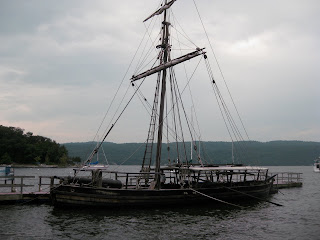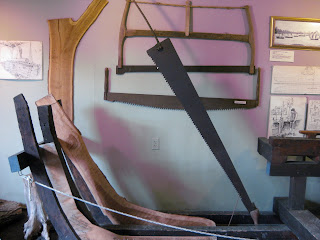 Welcome to Yet Another Great American Historical Region...
Welcome to Yet Another Great American Historical Region...The Lake Champlain Maritime Museum, located at 4472 Basin Harbor Road in Vergennes, VT, is a gem in the cultural and maritime pantheon of colonial and early American history. Among the various places I visited in Vermont this summer, this was surely one of the most historically intriguing, especially as I am a fan of all things maritime. And as I had already visited, documented, and described to you good readers not too long ago, the Hudson Maritime Museum in Kingston, NY, I thought that this would be a fine opportunity to share yet another maritime history locale. I arrived later in the day than I had expected at the home of my college friends Matthew and Melissa, and they suggested a trip to the Maritime museum, which was not too far away. Matt and I drove out to the museum on a circuitous country road--apparently, the museum was very close as the crow flies, but there was no direct route over a small creek, which separated house from museum. But that lent to a fine survey of the Vermont farm- and country-scape.
 Once we arrived at the museum, we had day passes (courtesy of Matt et al.) for the museum, which we could use the following day. Inside the main entrance was, as with most museums, a fine gift and book shop. (The first photo above is of the entrance to the museum). It was well designed and decorated, and offered displays of all things maritime, especially concerning the Champlain region, exploration, and boat building. After getting my fill of book perusing in the book shop, Matt and I decided to go through the museum as quickly as we could, considering it was getting ever-closer to closing time and it had started to sprinkle outside. Luckily, we evaded the rain, though there were a few moments when we thought it would be an all-out downpour. The second image (above) was the first "old" structure we came across, when coming out of the bookshop, and was nicely designed for touristic viewing, offering a variety of historical commentaries, placards, and sign boards.
Once we arrived at the museum, we had day passes (courtesy of Matt et al.) for the museum, which we could use the following day. Inside the main entrance was, as with most museums, a fine gift and book shop. (The first photo above is of the entrance to the museum). It was well designed and decorated, and offered displays of all things maritime, especially concerning the Champlain region, exploration, and boat building. After getting my fill of book perusing in the book shop, Matt and I decided to go through the museum as quickly as we could, considering it was getting ever-closer to closing time and it had started to sprinkle outside. Luckily, we evaded the rain, though there were a few moments when we thought it would be an all-out downpour. The second image (above) was the first "old" structure we came across, when coming out of the bookshop, and was nicely designed for touristic viewing, offering a variety of historical commentaries, placards, and sign boards. It started to sprinkle rain a little more fiercely, so we headed into the first of the many "educational barns," and found many delightful surprises. Maps, photos, drawings and prints of ships, and more. This image is an imprint of an old map of Lake Champlain, which I thought you kind readers might enjoy.
It started to sprinkle rain a little more fiercely, so we headed into the first of the many "educational barns," and found many delightful surprises. Maps, photos, drawings and prints of ships, and more. This image is an imprint of an old map of Lake Champlain, which I thought you kind readers might enjoy.In the next three images, you will see a barn housing boats--there were several of these "barns," though I'm not sure if they classify as barns per se, but I'm not sure what else to call them! The first image is a fantastic relic from long ago: it is the wheelhouse of a steamboat, long since gone and forgotten. The second image is an actual steam engine; and the third is a wider view of the "barn," where you can see other boats and maritime objects.
Between this last barn and the next was a little outdoor space for us to get sprinkled on. In this next building, which was actually less of a barn and more of a building, we discovered the great navigational history of Lake Champlain and the shipwrecks to be found in it. The first image is of the entrance, while the second is of a replica of an old horse-powered ferry. Even though it said not to enter without a "specialist" present, I tried it out, in order to see if it actually worked. It did. The third image is of an interesting and perhaps rather unheard of history: families living on canal boats (mostly in New York State). This portion of the display was very well done in regard to its attention to the historical tidbits and forgotten moments of the American maritime narrative.
Books on Nautical Archaeology
Well, when I had gone through the museum and was headed out the back door of the shipwrecks building, there was a little area dedicated to nautical archaeology adjacent to the state wreckage lab (that's what I'm calling it, but it was actually the nautical archaeology lab.) This was one of the first experiences in my bibliotours where a person laughed at my taking photos of books! "Those are gonna be some exciting pictures your getting there!" humored the archaeologist at the lab desk. I think my friend Matt gave me one of those "gotcha" grins. Oh well, all in a day's work, I suppose! Nonetheless, I managed to snap a few of these books, which are actually reports on dives, salvages, and other nautical archaeological work.
After suffering the tempered abuse and ridicule of the staff, because of my biblio-photography (ok, it wasn't that bad!), I engaged in a brief conversation with the archaeologist working behind the lab desk. He was gracious enough to show us some of the recent finds from Lake Champlain, which he'd been working on to clean and identify. Who knew they used the same tools as dentists to clean relics! The second image is of the conservation lab itself.
Old Boat or Kindlecraft?
One of the most extraordinary things I came across at this museum was the working replica of the ship Philadelphia II, which can be read about further on the following site provided by the maritime museum: http://www.lcmm.org/our_fleet/philadelphia.htm
The boat from which its pattern comes was an 18th century vessel, which sank very soon after construction, according to the docent on board the ship, when we visited. The replica was started in 1989, and later rebuilt and "upgraded" around 2007. The boat is often docked at North Harbor, just a trot down to the lake from the museum through some leafy woods. It was really quite extraordinary to see the sort of material used to build one of these vessels, as well as the size of the vessel and learn how many men were carried on it. Additionally, to see the type of cannons and other wares on the boat was both entertaining and educational.
Yet, it was not extraordinary enough to see the boat up close; another singular event took place, which can be marked as a first on my biblio-tours: a sea-Kindle. Back on my posting about "Books in Airports" I ran into my first bibliotouristic Kindle, but have not seen too many in my travels since. Yet on this boat, this floating piece of historical Americana, the docent of the boat had his very own Kindle for use, ready next to bomb and cannonball clusters! This was truly a Kindlecraft after all!
After getting over my Kindleshock, my horror of the e-text dissipated, because I realized that now I'd have a photo of a Kindle next to some weaponry on a replica of a 220+ year old boat. That's not something you come across everyday, so I was happy. I continued to marvel, of course, at the variety of accoutrements on the boat and other stylized compartments, such as this cooking dock or floating kitchen buried below the main deck, and surrounded by bricks. Imagine having to tend that fire, so that the wooden boat and hefty timbers wouldn't catch aflame! The final photo below is looking up at the mast into the dreary Champlain sky.
The Days of Boat Building
So for those of you who've ever had an interest in boat building, but never tried to build a boat: take a look at the next images, and reconsider your interests! It's a pretty complex art and craft, with a certain science behind it. I'm sure your next boat project will turn out beautifully, but will it float? Below are images from the boat building shed and tent (really, look at the bottom photo, it's like a fabric quonset hut). Tools, drawings, boat plans and canoes may be seen below.
Boats and Books
I leave you with this lot of photographs from the bookshop of the maritime museum. Surely not unique, as we've been to and seen other maritime museum bookshops, but this was quite a well stocked shop. And it had a great variety of materials. If now, you are in need of some guidance, either for books or general direction, I'd suggest getting a copy of "Practical Celestial Navigation," seen below. I can't promise that you'll be able to find this blog any quicker, but you might learn a few things about sailing a boat in the dark, or replicas of Champlain cruisers on murky lakes. I wonder what the world would have been like with GPS in the 15th century? Perhaps the Nina and the Pinta would have been more reliable, and places like the Champlain Maritime Museum would be selling how-to books called "Practical GPS Navigation."






















Is that a working model of a horse ferry?
ReplyDeleteNo--just one to show kids how it worked.
ReplyDeleteWow. That is so creative. Thanks
ReplyDelete